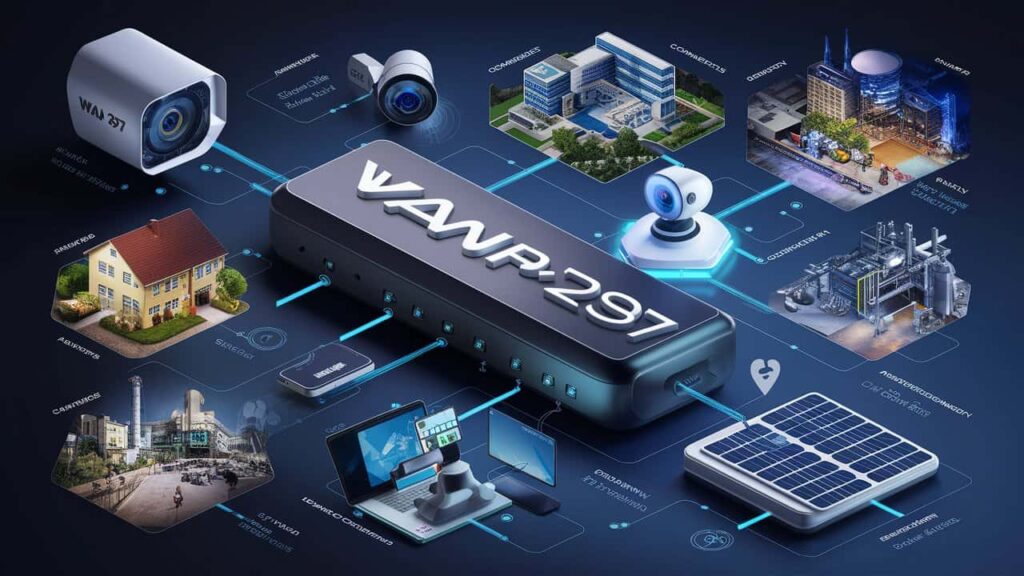Introduction to Wavr-297:
Wavr-297 stands at the forefront of modern communication technologies, promising revolutionary advancements in data transmission capabilities. It represents a pivotal shift from traditional communication methods by harnessing cutting-edge technologies to address the evolving demands of digital connectivity.
1. Definition and Purpose:
Wavr-297 is fundamentally designed to optimize the efficiency, speed, and reliability of data transmission within communication networks.
Unlike its predecessors, which often faced limitations in bandwidth and latency, Wavr-297 leverages advanced signal processing and encryption protocols to ensure seamless and secure communication channels.
Its primary purpose is to facilitate faster and more robust data exchange, supporting a wide range of applications from telecommunications to IoT and beyond.
2. Evolution and Development:
The development of Wavr-297 has been marked by continuous innovation and refinement. Initially conceived as a response to the escalating need for high-speed data transfer, its evolution has been driven by advancements in semiconductor technology, digital signal processing, and network architecture.
Over time, iterative improvements have enhanced its capabilities, making it a cornerstone of modern communication infrastructures worldwide.
Advantages of Wavr-297 in Communication Networks:

Wavr-297 offers multifaceted advantages that position it as a preferred choice in contemporary communication networks:
1. Enhanced Data Transmission:
At the core of Wavr-297’s appeal lies its unparalleled capacity for high-speed data transmission. By optimizing spectral efficiency and reducing signal interference, it enables networks to handle exponentially larger volumes of data without compromising on transmission speed or quality.
This capability is particularly crucial in environments where real-time data processing and rapid response times are imperative, such as in financial transactions or critical infrastructure monitoring.
2. Improved Network Efficiency:
Efficiency gains afforded by Wavr-297 extend beyond speed alone. By minimizing latency and optimizing bandwidth utilization, it enhances overall network efficiency.
This translates into smoother operation of networked applications, reduced network congestion, and improved user experience.
Such enhancements are particularly advantageous in congested urban areas or remote locations where reliable and efficient communication infrastructures are essential for socioeconomic development.
Technical Features of Wavr-297:
1. High-Speed Data Transfer:
Wavr-297 achieves exceptional speeds in data transfer, far surpassing traditional communication technologies.
Leveraging advanced modulation techniques and error correction algorithms, it ensures reliable transmission of data packets over extended distances with minimal loss or degradation.
This capability is instrumental in supporting bandwidth-intensive applications such as high-definition video streaming, cloud computing, and virtual reality simulations.
2. Low Latency and High Reliability:
Low latency is a hallmark feature of Wavr-297, enabling near-instantaneous data transmission between connected devices. This attribute is critical in applications requiring real-time interaction, such as online gaming, telemedicine, and autonomous vehicle navigation.
Moreover, its high reliability minimizes the risk of data loss or transmission errors, enhancing the overall stability and resilience of communication networks.
Applications of Wavr-297 in Communication:
Wavr-297’s versatility extends across diverse sectors, each benefiting from its transformative capabilities:
1. Telecommunication Industry:
In the telecommunications sector, Wavr-297 catalyzes the deployment of next-generation networks capable of supporting burgeoning consumer demands for high-speed internet access and multimedia content delivery. Telecom providers leverage its robust performance to deliver seamless connectivity solutions, thereby enhancing customer satisfaction and loyalty.
2. IoT and Smart Devices:
The proliferation of IoT devices and smart technologies hinges on reliable and efficient communication protocols like Wavr-297.
By providing low-power, high-bandwidth connectivity solutions, it supports the seamless integration and operation of interconnected devices, ranging from smart appliances and wearable gadgets to industrial sensors and smart city infrastructure.
3. Wavr-297 Technology and Innovation:
Core Technologies Used Key to Wavr-297’s success are its core technologies, including advanced modulation schemes (such as quadrature amplitude modulation), error correction coding techniques (like turbo codes and LDPC), and adaptive beamforming algorithms.
These technologies collectively optimize spectral efficiency, mitigate signal interference, and enhance network scalability, positioning Wavr-297 as a frontrunner in the realm of digital communication.
Future Trends and Developments:

Looking ahead, ongoing research and development initiatives aim to further enhance Wavr-297’s capabilities and expand its applicability across emerging technologies.
Anticipated advancements include higher data transmission rates, improved energy efficiency, and enhanced compatibility with emerging communication standards such as 5G and beyond.
Such innovations are poised to redefine the landscape of global connectivity, unlocking new possibilities for digital transformation across industries.
Comparison with Traditional Communication Technologies:
1. Advantages Over Existing Systems:
Compared to traditional communication technologies like 4G LTE or Wi-Fi, Wavr-297 offers distinct advantages in terms of speed, reliability, and scalability.
Its ability to operate at higher frequencies and utilize wider bandwidths enables it to accommodate the ever-growing demand for data-intensive applications without compromising on performance.
2. Challenges and Limitations:
Despite its transformative potential, the widespread adoption of Wavr-297 faces several challenges. These include initial deployment costs, compatibility issues with legacy infrastructure, and regulatory considerations pertaining to spectrum allocation and data privacy.
Addressing these challenges will be crucial in accelerating the adoption and integration of Wavr-297 into mainstream communication networks.
Implementing Wavr-297 in Networks:
1. eployment Strategies:
Successful deployment strategies for Wavr-297 involve phased implementation, starting with pilot projects in key urban centers or industrial hubs. This approach allows stakeholders to assess performance metrics, validate compatibility with existing infrastructure, and refine deployment protocols before scaling up to broader geographic regions.
2. Integration with Existing Infrastructure:
Integrating Wavr-297 with legacy communication infrastructure requires meticulous planning and coordination.
Compatibility testing, software upgrades, and hardware retrofits may be necessary to ensure seamless interoperability and minimize disruptions to ongoing operations.
Collaborative partnerships between technology providers, telecom operators, and regulatory authorities play a pivotal role in facilitating smooth integration processes.
Regulatory and Security Considerations:

1. Compliance and Standards:
Adherence to regulatory frameworks and industry standards is paramount in the deployment of Wavr-297. Compliance ensures legal validity, interoperability with global communication protocols, and adherence to spectrum allocation guidelines set forth by regulatory bodies.
Engaging with regulatory authorities early in the deployment phase fosters transparency and facilitates compliance with evolving regulatory requirements.
2. Data Security and Privacy:
Protecting data transmitted via Wavr-297 from unauthorized access and cyber threats is critical to maintaining trust and integrity within communication networks.
Implementing robust encryption protocols, access control mechanisms, and data anonymization techniques safeguards sensitive information against potential vulnerabilities and breaches.
Furthermore, ensuring transparency in data handling practices enhances user confidence and promotes responsible data stewardship.
FAQs about Wavr-297 in Communication Networks:
1. How does Wavr-297 differ from other communication technologies?
Wavr-297 distinguishes itself through its advanced modulation techniques and high-frequency operation, enabling superior data transmission speeds and lower latency compared to traditional communication technologies. Its adaptive beamforming capabilities further enhance signal reliability and network efficiency, making it well-suited for applications requiring real-time data processing and seamless connectivity.
2. How scalable is Wavr-297 technology?
Wavr-297 is highly scalable, allowing for easy expansion and integration into existing networks, making it suitable for both small-scale implementations and large-scale deployments.
3. What is the energy efficiency of Wavr-297?
Wavr-297 is designed to be energy-efficient, reducing power consumption while maintaining high performance, which is crucial for sustainable and cost-effective network operations.
4. How does Wavr-297 impact user experience?
Wavr-297 significantly improves user experience by providing faster data speeds, reduced latency, and more reliable connections, enhancing the performance of applications and services.
5. What kind of infrastructure investment is needed for Wavr-297?
Implementing Wavr-297 requires initial investment in compatible hardware and software upgrades, but it integrates well with existing infrastructure, minimizing overall costs in the long term.
6. Is Wavr-297 compatible with current network protocols?
Yes, Wavr-297 is designed to integrate seamlessly with existing network protocols, ensuring backward compatibility and interoperability across diverse communication environments. Its adaptive modulation schemes and error correction algorithms facilitate smooth coexistence with legacy infrastructure while paving the way for future technological advancements in global connectivity.
To Sum up:
In conclusion, Wavr-297 represents a paradigm shift in communication networks, offering unprecedented speed, reliability, and scalability for modern digital environments. As technological advancements continue to evolve, its role in facilitating seamless connectivity and empowering digital transformation across industries will be pivotal. By embracing Wavr-297, organizations can unlock new opportunities for innovation, efficiency, and connectivity, shaping a future where ubiquitous, high-performance communication networks redefine the way we live, work, and interact globally.


